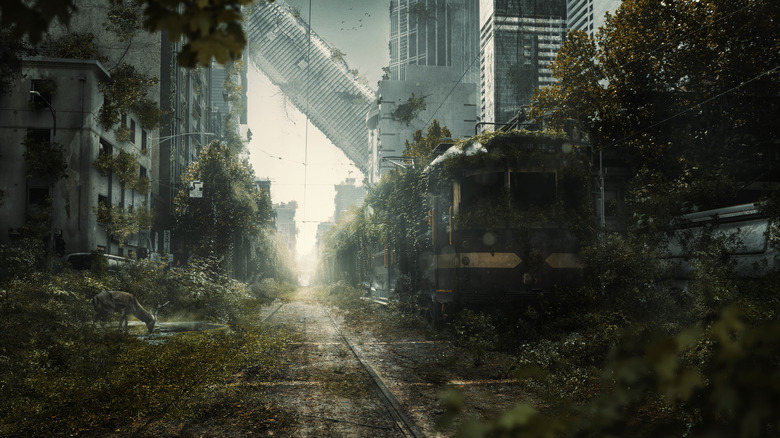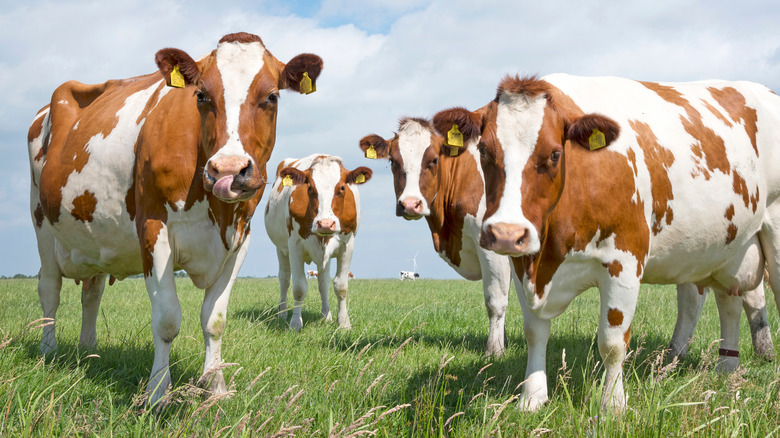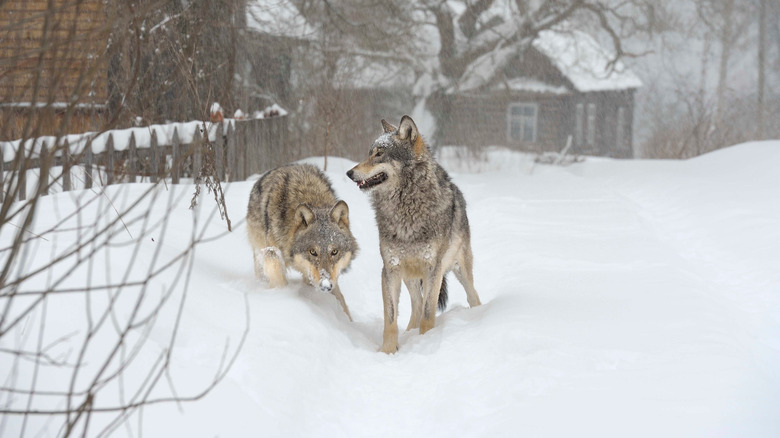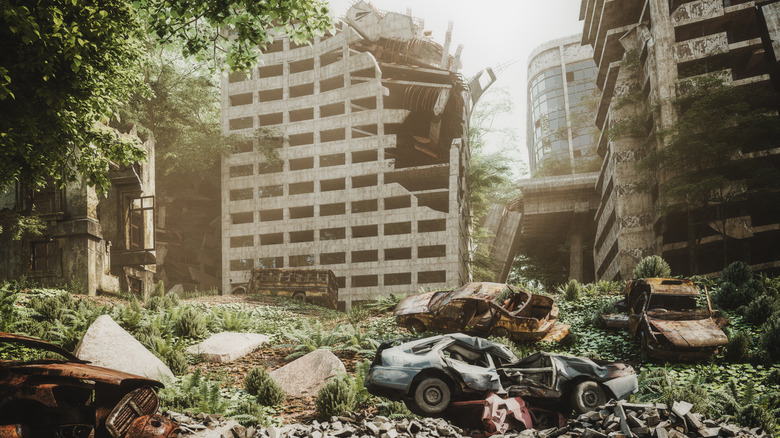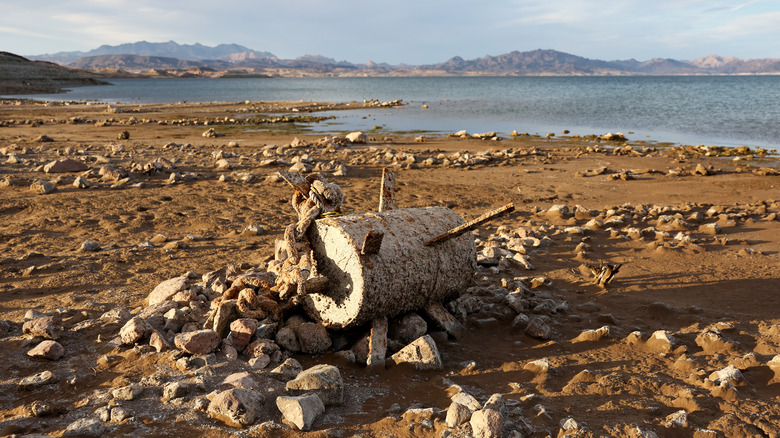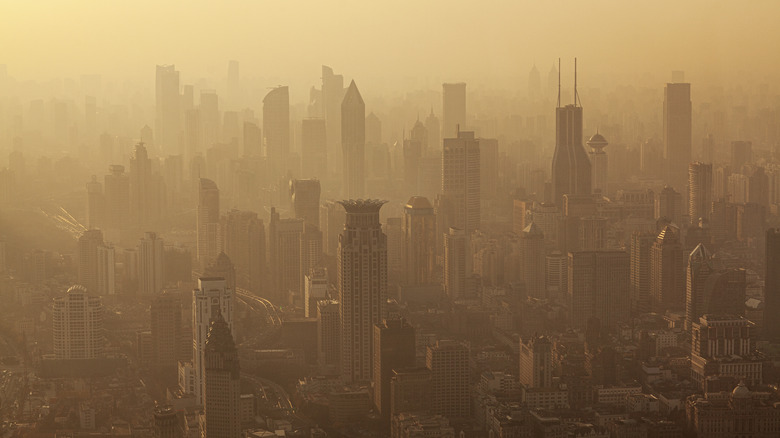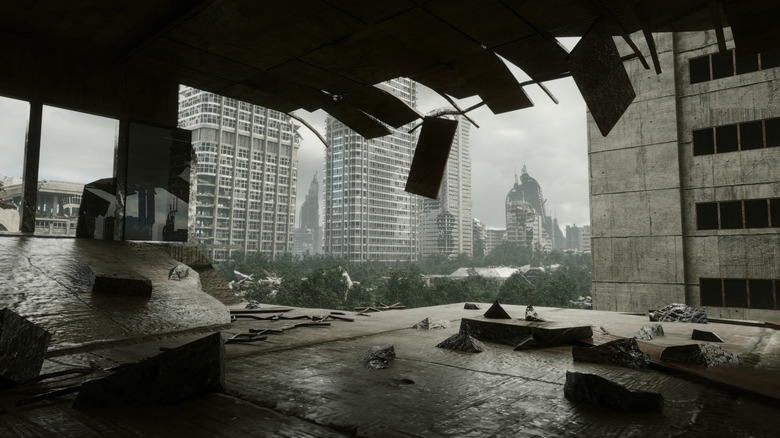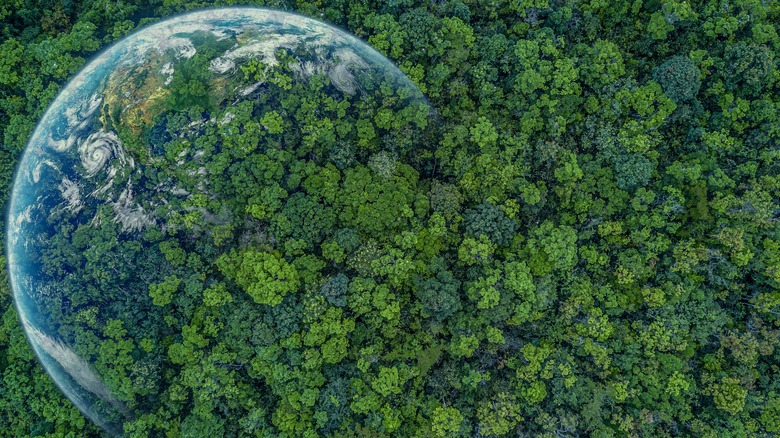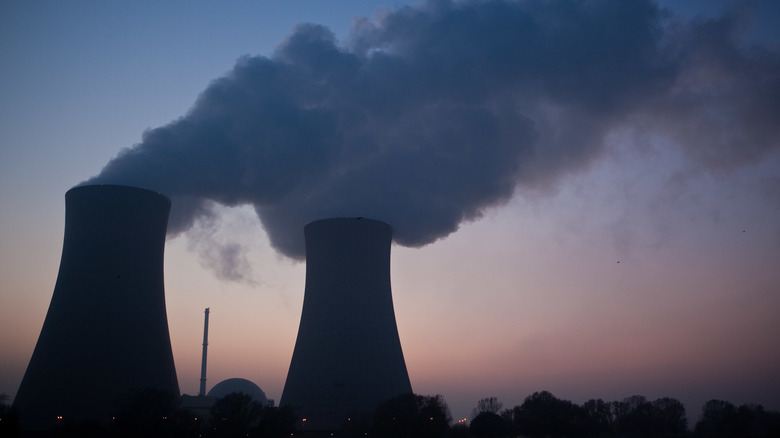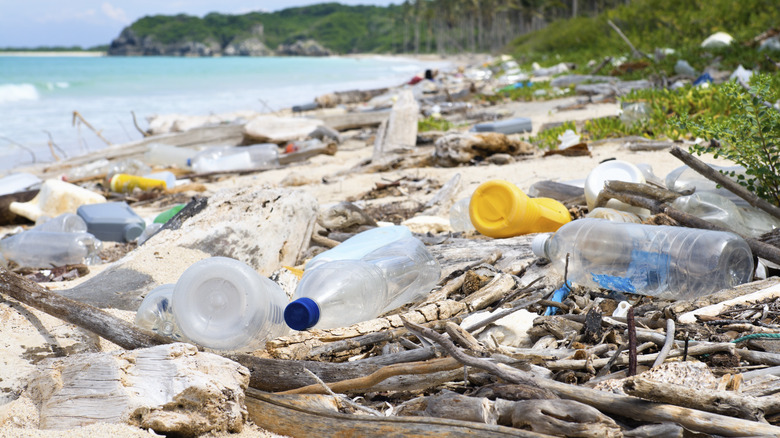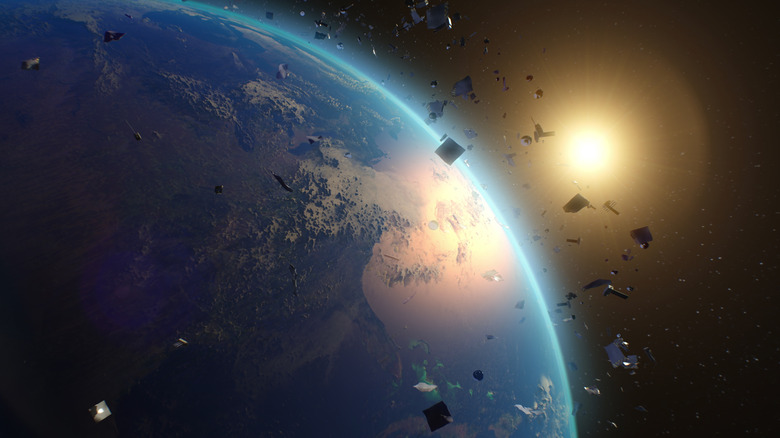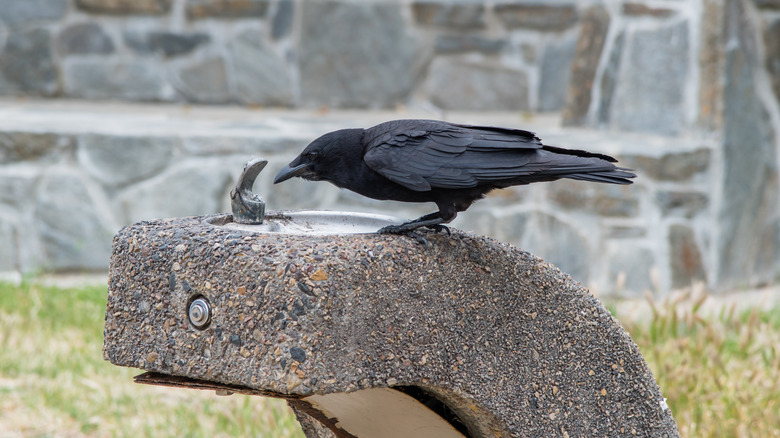This Is What Would Happen To Earth If Humans Went Extinct
It's understandably creepy to think about the end of our species. Many people are invested in not thinking about downbeat endings of any sort, and few are more of a bummer than the complete extinction of the human race. But, if you can get beyond that initial speed bump, the particulars of a human-free planet get pretty interesting. We've changed everything so much by building cities, churning out pollution, engaging in agriculture, and more that a dearth of people is an interesting thought experiment. What exactly would that look like? Some creatures might be very sad to see us go, but others would surely thrive without our interference. And, judging by the changes scientists saw across the globe during the lockdowns of the COVID-19 pandemic, other earth systems might perk up, too.
Of course, this isn't a simple story, especially since we're currently very entangled with the planet's ecosystems, for better or for worse. Even if every human went into the great beyond tomorrow, we would still leave behind some very obvious — and maybe even dangerous — traces of our complex society. Here's what would happen to the Earth and its remaining denizens if our species went extinct.
Many domesticated species would die out
In the immediate aftermath of human extinction, domesticated species would be in for a rough time. Relatively slow-moving and slow-thinking domestic animals were bred by humans to be docile, changes that are reflected in the structures of their brains. That's great if an animal is meant to live in a dairy barn or curled up at the foot of the bed, but, with humans gone, the adaptations bred into them by their former masters can become a serious liability. Carnivores would likely find animals like readily-confused sheep easy targets and make quick work of them. Dogs would probably make it through in some form, but the first few years without us and our delicious garbage would be rough for even the most seasoned street dog.
But animals aren't the only things humans have domesticated. Through selective breeding, we've also wrangled the genetic codes of plants, turning wild crops like the grass teosinte into the far more starchy and easily-consumed corn. Without the constant tinkering of humans, however, domesticated plants may revert back to wilder forms more like their ancient forebears. Even with humans still around and very much elbows-deep into agriculture, crops are sometimes known to revert back to something like their original forms, a process known as feralization. And without any interference from us at all, that change would move all the faster, and once-familiar crops like wheat, corn, and carrots would transform dramatically into wild plants more like emmer, teosinte, and Queen Anne's lace.
Some animals would do much better without humans around
Highly independent and mobile cats would likely do well for themselves in a human-free world. Pigs, which already go feral with little resistance, would also probably keep on keeping on while shedding their domesticated ways. And despite higher than average levels of radiation around the Chernobyl nuclear plant in Ukraine following its 1986 meltdown, some species have thrived in the plant's exclusion zone of about 18.6 miles around the rector. A 2015 research paper in Current Biology found that wild animals like deer and boar were doing quite well, while wolf populations around Chernobyl blossomed by over seven times since the accident, without human interference.
Meanwhile, with humans out of the picture, many species of insects would find themselves in a pesticide-free paradise. Other animals that gobble up insects would be quite happy to see the booming insect population. So, too, would the animals that prey on those growing numbers of well-fed insectivores, and on up the food chain to the tune of increased biodiversity overall.
That change wouldn't happen overnight, however. Humans have done a real doozy on various species across the globe. A 2018 study published in the Proceedings of the National Academy of Sciences found that mammal diversity will take millions of years to bounce back from the ongoing mass extinction — the sixth in the planet's history. More adaptable bugs might not need so long, but humanity's mark on the animal world would remain for quite a while after our extinction.
Many cities would be quickly overgrown
After a human extinction, some cities could disappear surprisingly quickly. Places in arid climates could stick around for a while, assuming they aren't buried by shifting sands too quickly. But anywhere with regular rainfall and a healthy wild population of plants is facing a green-tinged doom. Native Mesoamericans and archaeologists could already tell you as such, pointing to the ruins of the ancient Maya civilization that was quickly buried beneath plant overgrowth. Well into the 21st century, excavators have uncovered entire cities swallowed up by the jungle, like the Ocomtúm site in the Yucatán Peninsula, which was found after scientists used airborne lasers to see through heavy plant growth. Meanwhile, Cambodia's 900-year-old Beng Mealea temple is densely overgrown, while its more famous counterpart, Angkor Wat, is less so — but only through continuous human intervention.
Even cities in more temperate zones are likely to be full of plants in short order. If you live in an urban environment, just take a stroll outside and count the many plants you see sprouting up from cracks in the pavement. Without humans to bustle in and pull those weeds, they'll continue to keep growing, transforming some cityscapes into grasslands and budding forests punctuated by crumbling buildings. Those structures would be further broken down as growing plant roots work their way into degraded materials, breaking apart walls, roofs, and foundations, like some plants are wont to do even in the time of humans.
Water will change the landscape fairly quickly
Water is such an integral part of everyday life that we often forget about its awesome power. This is the substance that shaped the Grand Canyon after all, so why can't it shape human-free cities, too? In fact, many human settlements are primed to allow water to rapidly transform them. Large cities with subways can see those subterranean spaces flood within a matter of days without human engineers and pumps to maintain them. Given enough time, that water can start to eat away at the underground structures of buildings and streets, much like it has for rocks elsewhere when carving out natural canyons. Eventually, the ground will give way, and what was once a hidden river will be out in the open.
Pavement and similar materials will also have to contend with the invasion of water. In the winter, water will seep into cracks and freeze, expanding and breaking apart the material. Over enough seasons, the continual thawing and refreezing of water would cause roads and buildings to crumble. Homes and other buildings in wintry places would also see similar destruction, as pipes inside the walls would be more liable to freeze and burst as temperatures dipped.
The skies would look very different
In the 21st century, it's become pretty clear that air pollution is a major problem on our planet. Vehicles, factories, and herds of domestic cattle are just some of the many sources of greenhouse gasses that are heating up the planet and making the air difficult to breathe. The problem is especially obvious in cities where some of these sources are clustered together in dense population centers. In the short term, people dealing with the effects of bad air quality may suffer respiratory problems; in the long term, things can get even worse with nerve damage, cardiovascular disease, and increased rates of cancer.
With no humans, emissions-heavy weather like smog would practically disappear. We already got a preview of that, as COVID-19 lockdowns across the world were accompanied by a significant increase in air quality, as per a 2022 review in Environmental Sustainability.
The nighttime skies would also get a lot clearer as, in addition to decreased atmospheric pollution, light pollution would become a thing of the past. In the era of humans, light pollution is a serious issue wherein artificial lights don't just block out a spectacular view of the stars in our galaxy, but also likely have a hand in health problems like obesity, cancer, and mental health disorders. Without humans, soon the only lights in the nighttime sky would be the stars and the moon.
The planet would be much quieter
Humans are noisy creatures. You could probably have guessed that already if you live in an urban or suburban neighborhood, given the rumble of traffic, construction projects, and the general noise of bustling human life. But, with the COVID-19 pandemic shutdowns of 2020, many people stayed home. As a result, the planet got noticeably quieter. This isn't just a subjective observation, either. Researchers writing in a 2020 issue of Science found that all of the human hullabaloo got so muted that our seismic signature, as measured across the world, plummeted. The most dramatic change was a 50% drop in noise in Sri Lanka. So, too, did people detect serious quiet around what had once been bustling places, like schools.
It's reasonable to expect that, with no more humans, the planet would get quiet once again. Of course, animals and tectonic plates are bound to make plenty of their own noise, but research and lockdowns have made it clear that no one is quite as stupendously and consistently loud as humanity.
Some human-made structures would stick around
Walking through a major city today, it may feel as if the towering steel and glass skyscrapers will stand forever. Yet these might be some of the first to go in a world without people. Sure, steel manufacturers today might tout the durability of their structures, but most will admit that steel-clad buildings have a lifetime of between 50 to 100 years — and that's only if people are around to maintain them. And while modern skyscrapers are designed a little differently and are meant to withstand lightning strikes and intense winds, seeping water can eat away at concrete foundations and eventually cause steel to oxidize (rust). The reality is that buildings can't remain in perfect condition even with human help. Without any caretakers, steel will eventually rust and become unstable and glass will shatter after too much wind vibration, fluctuations in temperature, or even seemingly at random.
Buildings made out of more natural materials, such as stone and brick, are more likely to last the longest, in part because they won't oxidize in the same way that steel and other metals do. But nothing is forever, and even these structures will degrade as the years wear on and the natural environment does its steady work. The things we've built that are most likely to stick around the longest and leave evidence of our existence would probably be buried or subterranean structures, like mining operations or nuclear waste disposal sites buried deep in the earth.
The climate would take a long time to recover
Sure, in the event of a massive and complete human extinction, there would be no more humans and human-made machines belching out greenhouse gasses. During the early shutdown days of the COVID-19 pandemic, scientists saw a dramatic improvement in air quality and a drop in planet-warming greenhouse gasses, per a 2021 paper published in the Proceedings of the National Academy of Sciences. Yet, that effect proved to be temporary. What's more, even if humans were completely wiped out and our technology ceased to function right away, the climate still wouldn't recover overnight. Current estimates have it that all of the CO2 currently in our atmosphere would take thousands of years to drop down to pre-human levels. That's in a best-case scenario, too, which doesn't account for a runaway warming effect that could melt ice and permafrost near the poles even without our presence, a situation that would release even more previously-stored greenhouse gasses.
Then, there would also be emissions from lingering bits of our species, like power plants or oil and gas sources that could explode or catch fire when left unattended. Those disasters could easily release large amounts of greenhouse gasses into the atmosphere, adding another few centuries or longer onto the time it would take the climate to return to pre-industrial levels.
Humans could leave behind explosive surprises
As many action movies and science-focused media personalities have made clear, humans love a good explosion. Well, a good controlled explosion, as any nuclear technician worth their salt will strenuously remind you. But, without those techs or any other humans around, nuclear power plants and other remaining human structures could turn into nasty explosive surprises. Nuclear plants in particular need a constant supply of water to cool down radioactive fuel. If that flow of coolant stops, the fuel can overheat and a nuclear meltdown can occur. For power plants in the U.S., this cooling system is powered by electricity from an outside grid. This is meant to be a failsafe, as a self-powered plant experiencing an electrical failure can see things go from bad to very, very worse in short order. But, without any human intervention and a failed electrical grid, a meltdown could happen anyway and release unknown quantities of radioactivity into the environment.
Other power sources could also meet similar fates, like runaway fires at oil wells and explosions in corroding natural gas lines, to name just a couple of hazards. Even breweries and bottling plants might be rocked by explosions, as untended fermentation tanks (perhaps dealing with clogged pressure safety valves) fail to deal with the buildup of heat and pressure inside.
Human garbage would stick around for a long time
Long, long after humans have gone extinct, our garbage will remain to tell the tale of our species. According to the Environmental Protection Agency (EPA), Americans put an estimated 146.1 million tons of waste into landfills in 2018. More than 18% of that garbage consisted of plastic, and this amount has only increased over time. According to the EPA, Americans have gone from generating 88.1 million tons of waste in 1960 to 292.4 million tons in 2018, though rates of recycling and composting have gone up — landfills went from seeing 94% of waste in 1960 to 50% in 2018.
Still, even if we're doing better when it comes to managing waste, what was placed into landfills or simply littered around our environment is going to stick around for a long, long time. Plastics will take decades or even centuries to decompose. Meanwhile, the Great Pacific Garbage Patch, which includes a 620,000 square-mile expanse of junk floating between California and Hawaii, has stuck around for long enough that local invertebrates have begun using it as a breeding ground, including coastal species that wouldn't otherwise have made it out so far into the open ocean (via Nature Ecology & Evolution). Though some microbes can help break down plastics, the sheer amount of plastic and other waste left behind in the wake of humanity will take a seriously long time to fade away.
Space junk could come back to Earth
For anyone needing a bit of a pick-me-up after contemplating the apocalypse, consider the space probes and radio signals emanating out from our planet. Radio waves have been making their way out into space for decades now and, if someone out there had sufficiently strong monitoring equipment, they could catch bits and pieces of our transmissions. Eventually, though, the signal would die out as it travels farther and farther away, though we've got a few million years before it fuzzes into nothing. Meanwhile, the more substantial Voyager probes (launched in 1977) have a better chance of making it. Voyager 1 crossed out of our solar system in 2012, while Voyager 2 followed in late 2018. Though both were originally meant to survey our solar system, they now offer the most obvious physical evidence that we existed — at least, if anyone manages to come across these tiny bits of machinery in the vastness of space.
Meanwhile, the stuff immediately around our planet will face a different fate. Satellites can remain in orbit for a long while, especially if they can maintain just the right balance between the centrifugal force pushing it away from Earth and the gravity that pulls it back. However, any issues with orbit, whether that's friction with the planet's atmosphere or collisions with other bits of space junk, could tip the balance in gravity's favor and send satellites to burn up in the atmosphere and rain debris on the planet below.
Another species might eventually take our place
In the absence of humans, who might take on the dubious honor of being the most intelligent, dangerous, and invasive species on Earth? Some scientists have proposed that it could be no one. After all, bacteria and insects are highly successful even in the face of human intervention, though no one's expecting to read the next great novel from a member of either group. Intelligence and expansionist tendencies can have an evolutionary advantage, but it's not a prerequisite for a successful species. So, it would be entirely possible that Earth plugs along with no intelligent human successors at all.
But, for many, that answer is boring and a bit depressing. And if humans evolved, why couldn't another highly intelligent species take our place for round two of the planet-dominating game? The most obvious choice would be our closest relatives: apes. They've got some serious smarts, highly social communities, and opposable thumbs, all of which arguably helped us move up in the world. Birds might also stand to step in here, especially if we're talking about some of the most intelligent avians like crows, ravens, and other corvids. Or, if you want to move a bit more into the outfield, perhaps a human-free world would make way for intelligent cephalopods like octopuses. Managing the transition from water to dry land would be tough, but why should air-breathing species dominate the already ocean-covered new world anyway?
